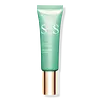Clarins SOS Primer Versus Clarins Fix' Make-Up
What's inside
What's inside
 Key Ingredients
Key Ingredients

 Benefits
Benefits

 Concerns
Concerns

 Ingredients Side-by-side
Ingredients Side-by-side

Water
Skin ConditioningDimethicone
EmollientButylene Glycol
HumectantGlycerin
HumectantPhenyl Trimethicone
Skin ConditioningVinyl Dimethicone/Methicone Silsesquioxane Crosspolymer
CI 77891
Cosmetic ColorantAlcohol
AntimicrobialPEG/PPG-18/18 Dimethicone
EmulsifyingC12-15 Alkyl Benzoate
AntimicrobialSodium Chloride
MaskingSilica
AbrasiveSynthetic Fluorphlogopite
Bisabolol
MaskingParfum
MaskingEthylhexylglycerin
Skin ConditioningDisodium EDTA
Stearalkonium Hectorite
Gel FormingPropylene Carbonate
SolventAluminum Hydroxide
EmollientCI 77492
Cosmetic ColorantCI 42090
Cosmetic ColorantHexyl Cinnamal
PerfumingBenzyl Benzoate
AntimicrobialSodium Lauroyl Glutamate
Butylphenyl Methylpropional
PerfumingPhenoxyethanol
PreservativeLysine
Skin ConditioningAlpha-Isomethyl Ionone
PerfumingMagnesium Chloride
Furcellaria Lumbricalis Extract
Skin ConditioningPancratium Maritimum Extract
BleachingLinalool
PerfumingCitronellol
PerfumingLimonene
PerfumingEugenol
PerfumingCamellia Sinensis Leaf Extract
AntimicrobialTriethoxycaprylylsilane
Lapsana Communis Flower/Leaf/Stem Extract
Skin ConditioningMaris Sal
Skin ConditioningWater, Dimethicone, Butylene Glycol, Glycerin, Phenyl Trimethicone, Vinyl Dimethicone/Methicone Silsesquioxane Crosspolymer, CI 77891, Alcohol, PEG/PPG-18/18 Dimethicone, C12-15 Alkyl Benzoate, Sodium Chloride, Silica, Synthetic Fluorphlogopite, Bisabolol, Parfum, Ethylhexylglycerin, Disodium EDTA, Stearalkonium Hectorite, Propylene Carbonate, Aluminum Hydroxide, CI 77492, CI 42090, Hexyl Cinnamal, Benzyl Benzoate, Sodium Lauroyl Glutamate, Butylphenyl Methylpropional, Phenoxyethanol, Lysine, Alpha-Isomethyl Ionone, Magnesium Chloride, Furcellaria Lumbricalis Extract, Pancratium Maritimum Extract, Linalool, Citronellol, Limonene, Eugenol, Camellia Sinensis Leaf Extract, Triethoxycaprylylsilane, Lapsana Communis Flower/Leaf/Stem Extract, Maris Sal
Water
Skin ConditioningPropylene Glycol
HumectantAloe Barbadensis Leaf Juice
Skin ConditioningSucrose
HumectantButylene Glycol
HumectantGlycerin
HumectantRosa Damascena Flower Water
MaskingPhenoxyethanol
PreservativePhenethyl Alcohol
MaskingAllantoin
Skin ConditioningDisodium EDTA
Citrus Paradisi Fruit Extract
Skin ConditioningSodium Hydroxide
BufferingBenzyl Alcohol
PerfumingCitric Acid
BufferingPotassium Sorbate
PreservativeSodium Benzoate
MaskingLapsana Communis Flower/Leaf/Stem Extract
Skin ConditioningCitronellol
PerfumingGeraniol
PerfumingCamellia Sinensis Leaf Extract
AntimicrobialDehydroacetic Acid
PreservativeWater, Propylene Glycol, Aloe Barbadensis Leaf Juice, Sucrose, Butylene Glycol, Glycerin, Rosa Damascena Flower Water, Phenoxyethanol, Phenethyl Alcohol, Allantoin, Disodium EDTA, Citrus Paradisi Fruit Extract, Sodium Hydroxide, Benzyl Alcohol, Citric Acid, Potassium Sorbate, Sodium Benzoate, Lapsana Communis Flower/Leaf/Stem Extract, Citronellol, Geraniol, Camellia Sinensis Leaf Extract, Dehydroacetic Acid
Ingredients Explained
These ingredients are found in both products.
Ingredients higher up in an ingredient list are typically present in a larger amount.
Butylene Glycol (or BG) is used within cosmetic products for a few different reasons:
Overall, Butylene Glycol is a safe and well-rounded ingredient that works well with other ingredients.
Though this ingredient works well with most skin types, some people with sensitive skin may experience a reaction such as allergic rashes, closed comedones, or itchiness.
Learn more about Butylene GlycolCamellia Sinensis Leaf Extract is derived from the leaves of the tea plant. Black tea, green tea, and oolong tea are all harvested from this plant.
This ingredient has many skin benefits:
This ingredient contains polyphenols, a strong antioxidant. Antioxidants help fight off molecules that damage skin cells.
On top of that, the antioxidants in green tea neutralize free-radicals from the sun. This gives the skin some extra UV protection, but should not replace sunscreen.
Many components of tea have anti-inflammatory properties.
Polyphenols and L-theanine help soothe the skin and reduce irritation. The caffeine in Camellia Sinensis Leaf Extract helps calm inflamed blood vessels.
Other compounds found in tea include: Vitamin Bs, linoleic acid, magnesium, calcium, iron, and zinc.
Research has shown both drinking Camellia Sinensis Leaf Tea and applying it to the skin can help boost skin elasticity and hydration. Studies also show using tea extract may reduce sebum, or oil, production.
Learn more about Camellia Sinensis Leaf ExtractCitronellol is used to add fragrance/parfum to a product. It is often derived from plants such as roses. In fact, it can be found in many essential oils including geranium, lavender, neroli, and more. The scent of Citronellol is often described as "fresh, grassy, and citrus-like".
Since the Citronellol molecule is already unstable, Citronellol becomes irritating on the skin when exposed to air.
Citronellol is a modified terpene. Terpenes are unsaturated hydrocarbons found in plants. They make up the primary part of essential oils.
Citronellol is not able to be absorbed into deeper layers of the skin. It has low permeability,
Citronellol is also a natural insect repellent.
Learn more about CitronellolDisodium EDTA plays a role in making products more stable by aiding other preservatives.
It is a chelating agent, meaning it neutralizes metal ions that may be found in a product.
Disodium EDTA is a salt of edetic acid and is found to be safe in cosmetic ingredients.
Learn more about Disodium EDTAGlycerin is already naturally found in your skin. It helps moisturize and protect your skin.
A study from 2016 found glycerin to be more effective as a humectant than AHAs and hyaluronic acid.
As a humectant, it helps the skin stay hydrated by pulling moisture to your skin. The low molecular weight of glycerin allows it to pull moisture into the deeper layers of your skin.
Hydrated skin improves your skin barrier; Your skin barrier helps protect against irritants and bacteria.
Glycerin has also been found to have antimicrobial and antiviral properties. Due to these properties, glycerin is often used in wound and burn treatments.
In cosmetics, glycerin is usually derived from plants such as soybean or palm. However, it can also be sourced from animals, such as tallow or animal fat.
This ingredient is organic, colorless, odorless, and non-toxic.
Glycerin is the name for this ingredient in American English. British English uses Glycerol/Glycerine.
Learn more about GlycerinWe don't have a description for Lapsana Communis Flower/Leaf/Stem Extract yet.
Phenoxyethanol is a preservative that has germicide, antimicrobial, and aromatic properties. Studies show that phenoxyethanol can prevent microbial growth. By itself, it has a scent that is similar to that of a rose.
It's often used in formulations along with Caprylyl Glycol to preserve the shelf life of products.
Water. It's the most common cosmetic ingredient of all. You'll usually see it at the top of ingredient lists, meaning that it makes up the largest part of the product.
So why is it so popular? Water most often acts as a solvent - this means that it helps dissolve other ingredients into the formulation.
You'll also recognize water as that liquid we all need to stay alive. If you see this, drink a glass of water. Stay hydrated!
Learn more about Water